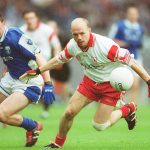IN Gaelic football, we hear it all the time: “He’s naturally quick, you can’t coach speed.” Or, “Just sprint more and you’ll get faster.” Or worse still, “Too much gym work will slow you down.” These old sayings have been thrown around for years, but they’re holding players back. Let’s break down the biggest misconceptions about speed training for GAA players and set the record straight.
Myth 1: “Some lads just can’t get faster.”
This is probably the biggest lie in the book. The truth is, almost every player can get faster. The only exception? Elite Olympic sprinters are already at their absolute peak. For the rest of us, there’s always room to move the needle. The question is how.
If your speed work is sloppy or thrown in at the end of training when you’re half dead, of course you won’t see much improvement.
But with the right plan – quality sprint sessions, proper rest, and a coach who knows what they’re doing – every Gaelic footballer can boost their pace.
Myth 2: “Just sprint more and you’ll get quicker.”
Wrong again. Yes, sprinting more helps at first, but that only goes so far. Real speed gains come when you train the parts that make you fast – like explosive power, proper acceleration mechanics, how you hit the ground, and how you use your arms and core to drive forward. In Gaelic football, you also need to stop, start, change direction and do it again at full tilt. That’s why good speed training isn’t just about “running fast in a straight line.” It’s about building every piece of the puzzle.
Myth 3: “Strength training slows you down.”
This one needs to die off, fast. If you lift like a bodybuilder, yes, you might bulk up the wrong way. But proper gym work is essential for speed. Strong glutes, hamstrings, calves and a solid core help you explode off the mark and stay powerful over distance. The key? Lift heavy enough to build strength but focus on moving fast – think jumps, hip thrusts, resisted sprints – not endless slow squats. Fast players are strong players.
Myth 4: “Max speed is too risky, you’ll pull a hammy.”
Some coaches shy away from top speed work because they fear hamstring injuries. Ironically, this increases injury risk. In matches, you’ll hit top speed whether you’ve trained for it or not. If your body isn’t ready, that’s when things go wrong. Building up to full speed sprints in training makes you safer, not weaker. Good speed plans gradually progress in intensity, giving your body time to adapt and your hamstrings the resilience they need.
Myth 5: “More is better.”
More sprints, more drills, more volume – not true. Quality beats quantity every time. Speed training is tough on your nervous system. If you’re exhausted, your technique falls apart and injuries creep in. Keep it sharp: short bursts, full recovery, and laser focus on form.
Myth 6: “One-size-fits-all works for everyone.”
No two Gaelic footballers are the same. Some need more strength, others need more technical work. Some have old injuries that change how they run. Smart coaches adapt plans for the player in front of them, not just what worked for someone else.
The Takeaway
Speed isn’t magic. It’s built smartly, step by step. For GAA players, that means training acceleration, max velocity, and change of direction, doing the right gym work, respecting recovery, and dropping outdated myths. Nail these and you won’t just be playing fast, you’ll be winning fast.
Receive quality journalism wherever you are, on any device. Keep up to date from the comfort of your own home with a digital subscription.
Any time | Any place | Anywhere














